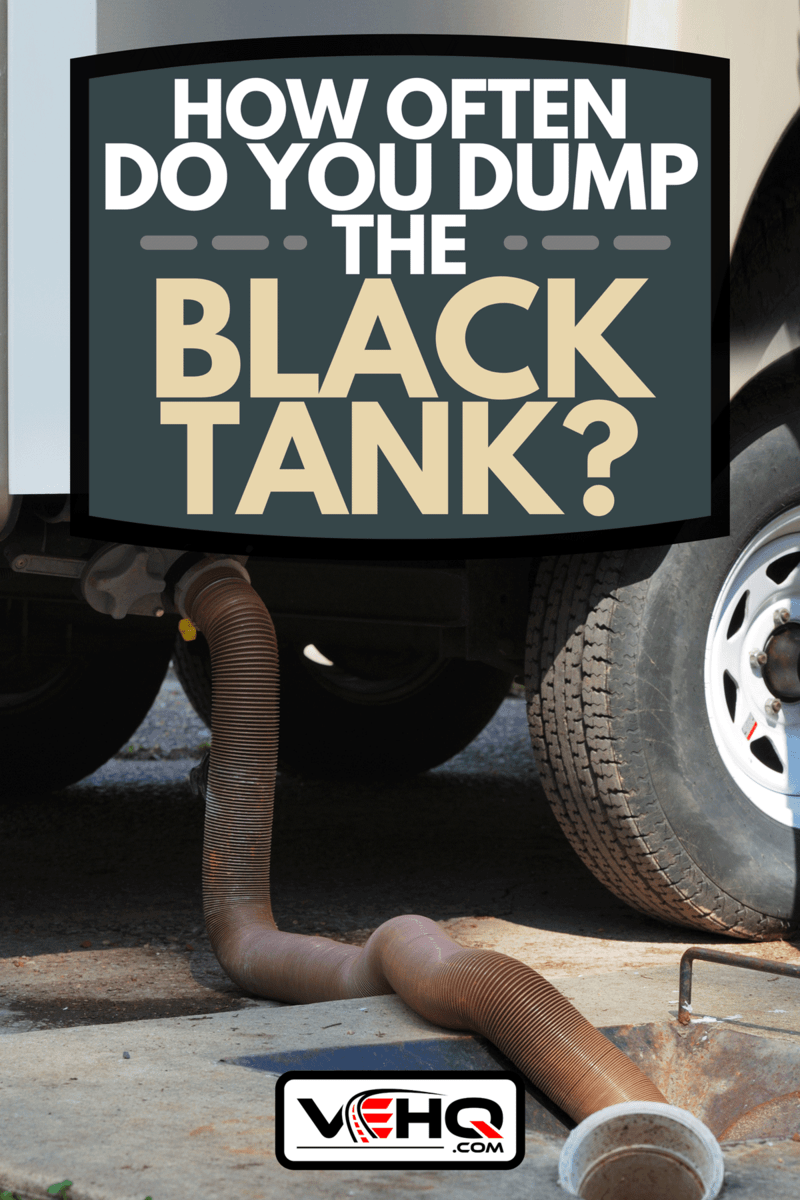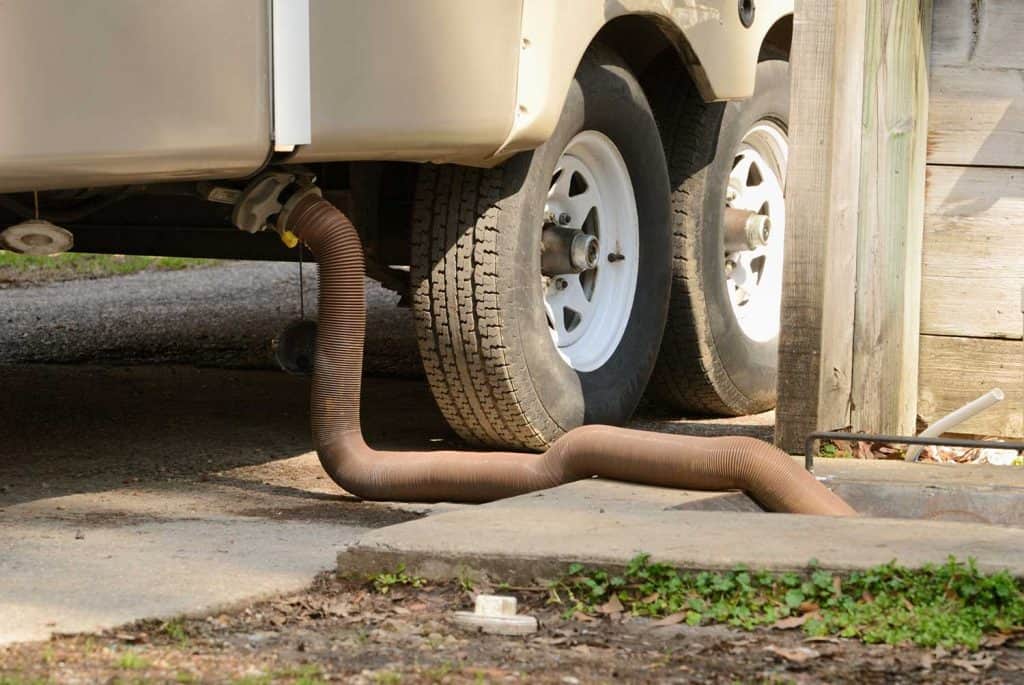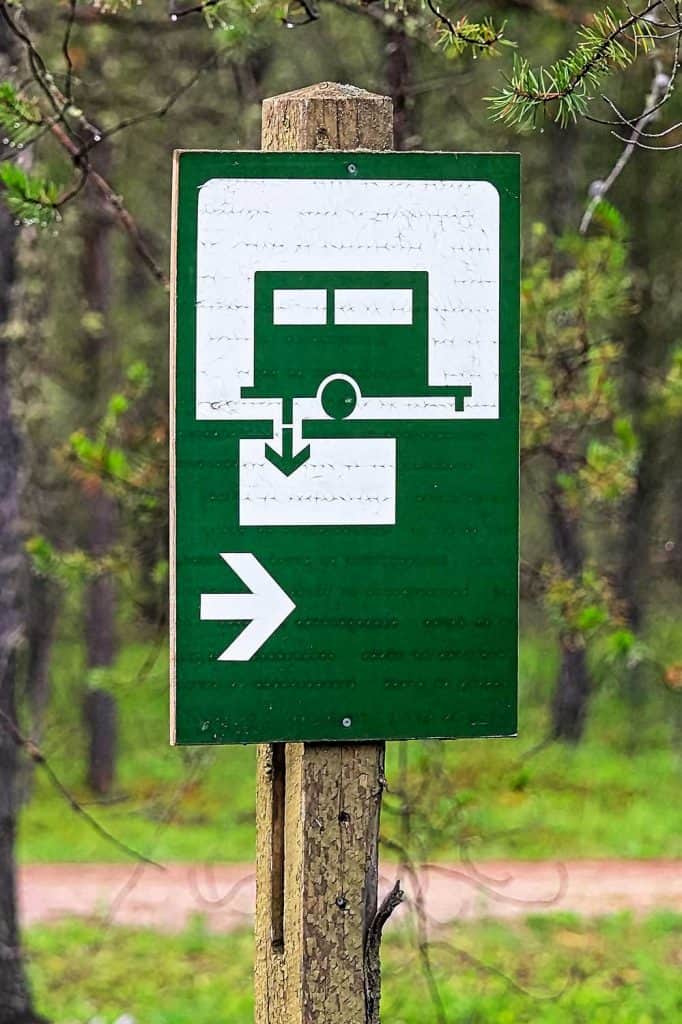Not everything about camping is quaint and romantic. Sooner or later, someone has to dump the tanks and clean them, which is a job no one seems to want to volunteer for. If you've drawn the shortest straw and are assigned this task, you might be wondering how often you should be dumping the RV's black tank. We've done the research to bring you the answer.
You should dump your black water tank every 3-5 days or when it gets to be two-thirds full, whichever is first. The steps to emptying your black water tank are listed below:
- Put on gloves
- Connect the hose to the black tank water drain
- Run the other end of the hose into the wastewater port
- Open the black water valve and empty
- Open the gray water valve and empty
- Flush hose
- Disconnect and stow
Being able to safely and legally empty your camper or RV's black water tank is critical knowledge to have before you start out on the road. We've researched these tanks from a variety of professional sources and camping blogs, and have listed all of our findings ahead in this post. For the answers to common black tank questions and more, read ahead in this post.

Emptying Your Black Tank Step-By-Step
Above, we listed the steps in emptying out your camper or RV's black water tank. For a detailed step-by-step process on how to accomplish this with no trouble, read below.
1. Put on gloves
This can be dirty work, so be sure you are equipped with some heavy-duty rubber gloves. Rubber gloves can be easily cleaned when you're finished with the job, and offer your hands and arms some great protection.
Click here to view these rubber cleaning gloves on Amazon.
2. Connect the hose to the black tank water drain
Carefully and firmly attach a good quality sewer hose to the camper or RV's outlet drain. You'll see that there are two valves here, one for your system's black water tank and one for the gray water tank. Note which one is which, and proceed to the next step without opening either valve.
3. Run the other end of the hose into the wastewater port
The other end of your sewer hose should be placed firmly into the wastewater port. If it's able to be attached, make sure it's attached correctly. Some will allow for you to insert the hose a foot or so into the port without any attaching necessary. Make sure you're familiar with the type of wastewater port that you're using and be sure that your hose is inserted or attached correctly.
4. Open the black water valve and empty
Now that your hose is attached at both ends, it's time to empty the tanks. Slowly open the black water tank valve first, allowing it to empty out. This will carry all of the waste from your toilet's holding tank safely and cleanly out and into an approved sewer or septic system.

5. Open the gray water valve and empty
Now that the black water tank is empty, you'll want to move on to emptying the gray water tank. Close the valve for the black water tank, then slowly open the gray water tank's valve. Allow it to drain until it's empty.
6. Flush hose
If you're in a place that has a good freshwater supply, you'll want to consider flushing the hose with it. While the gray water will have dislodged and removed a lot of material and bacteria, a good flush of freshwater will do even more.
7. Disconnect and stow
Now that you're finished, you'll need to disconnect the hose from your camper's drain valves. Be sure both valves are firmly closed. Then carefully and slowly detach the hose. Store it until it is needed again.
How long can you leave waste in a black tank?
Our research shows that most camping experts maintain that you can safely leave black water in the tank for up to ten days. Most, however, state that you should empty it out after no more than a week.
Of course, this also depends upon usage. A camper with a smaller black tank that is being used by a lot of people will mean that it needs to be emptied more often.
We should also point out that using the correct type of toilet paper is critical in keeping your black water tank functioning and clog-free. You'll want a paper that is specific to an RV or camper. It disintegrates faster than ordinary household toilet paper.
Click here to see this RV and camper approved toilet paper on Amazon.
Always keep a close eye on how full your camper's black water tank is getting so that you can empty it in a timely manner and avoid a mess.
Should you empty the gray water or black water first?
While you're technically able to drain either type of water first, it's highly recommended to drain the black water before the gray water.
The black water is the dirtiest and carries the most bacteria. It also smells the worst. By allowing the black water tank to drain first, you're then able to immediately flush any black water remnants out of the hose by draining the gray water right after. Draining the gray water last helps clean the hose in a way, and keeps it inside of it from smelling as bad.
Can you dump the black water tank anywhere?

Absolutely not! Dumping wastewater just anywhere is illegal and for good reason. Imagine camping somewhere and having to smell (or step in) dumped black water left behind by the person before you. For sanitation reasons, there are strict regulations that govern where and how you dump black water tanks.
The best place to dump your black water tank is at the campground, using their septic or sewage hookups. Modern campgrounds are outfitted with these, and their usage is typically included in the camping fee that you've already paid.
But what if you're in a more rustic campground, or are boondocking off the grid somewhere? Obviously, you won't have access to a septic or sewer system in this situation. So what are your options when your black water tank is getting full?
Truck stops
Most truck stops have this option for those that travel with a black water tank. When your own is getting full, consider trying out the closest one. You'll of course have to pay a fee, but it's better than having backflow.
Interstate rest areas
A lot of interstate rest stops will have safe and legal spots to empty black water tanks. Of course, you'll want to locate and map out the ones that do prior to your camping trip. Like truck stops, there will be a small fee to use these facilities.
RV Parks
And you can always pull into a modern RV park and pay to use their system. Even if you aren't camping at this park, most RV parks will allow you to dump your black water tank, so long as you pay their required fee.
Portable wastewater tanks
In a pinch, you might find great value in investing in a portable waste water tank. These watertight tanks can be easily and safely stored and then wheeled out to connect to your camper's black and gray water tanks for drainage.
When it's full, you wheel it back and stow it until it can be legally emptied. While you may not be able to empty the entire contents of both tanks into it, you'll be able to empty enough so that you can get back to business before you arrive at a place where you can legally dump the remaining contents of your tank.
Click here to see this portable waste water tank on Amazon.
Remember that dumping wastewater onto the ground or into a waterway is illegal, and punished severely in most locations. If you're boondocking, always have a plan on where you can safely and legally dump your black tank water so that you're not caught in a messy situation.
Can you dump gray water on the ground?
Since gray water is from the camper's sinks and showers, it's ok to dump this directly onto the ground, right?
The answer to this will depend on the state that you're traveling in, as well as the local regulations for the camping site you might be set up at. Some states allow it, some prohibit it by law.
It's also important to note that while some places will allow the dumping of gray water, they still might have a different definition of gray water than you. It was commonplace to define gray water as anything that wasn't from the toilet. However, some areas consider any water that comes into contact with food as "black water," and would need to be disposed of in the manner that you dispose of black water.
Food contaminates water with germs and bacteria, so some areas will treat the water that comes into contact with it as black water.
For these reasons, it's very important to know all of the state and local regulations regarding gray water disposal before you dump it onto the ground.
How often to clean a black water tank?
Using commercial cleaners and deodorizers on a recommended basis will keep your self-contained system smelling fresh and free of clogs. But how often should this be done?
It's suggested that you clean your camper's black water tank at the end of every camping trip, as well as when you are about to store your camper for the season. These cleaners not only cleanse your system, but they help to break down any toilet paper that might be clinging to the sides of the tank.
Click here to see this cleaner on Amazon.
In Closing
We've learned a lot about black water tanks in this post. You should know now the steps you'll need to take to empty the tanks, as well as places that you can safely and legally dump them. This post also covered how long you can safely let black water sit in the tank, and how often you need to empty it.
If you found this post about black water tanks to be informative, we also suggest the following posts:
What Bathroom Accessories Should You Get For A New RV?
What Bathroom Accessories Should You Get For A New RV?
How Much Does RV Camping Cost? [A Detailed Analysis With Examples]




